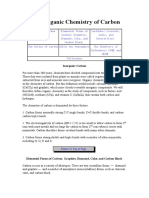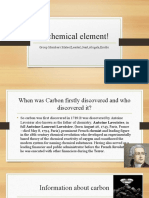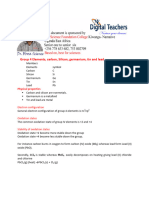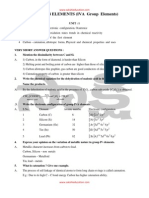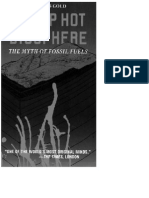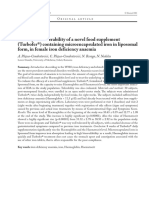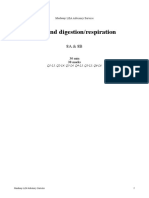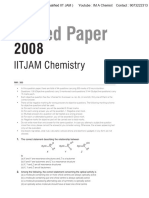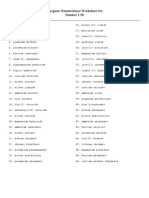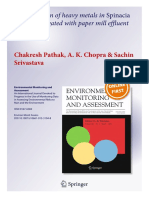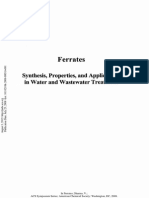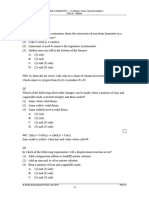S2 Chemistry Notes Carbon and Its Compounds
S2 Chemistry Notes Carbon and Its Compounds
Uploaded by
nabyamaeria50Copyright:
Available Formats
S2 Chemistry Notes Carbon and Its Compounds
S2 Chemistry Notes Carbon and Its Compounds
Uploaded by
nabyamaeria50Original Title
Copyright
Available Formats
Share this document
Did you find this document useful?
Is this content inappropriate?
Copyright:
Available Formats
S2 Chemistry Notes Carbon and Its Compounds
S2 Chemistry Notes Carbon and Its Compounds
Uploaded by
nabyamaeria50Copyright:
Available Formats
CARBON AND ITS COMPOUNDS
Carbon is an element in period II and group IV in the periodic table. It has atomic
number of six.
Occurrence of carbon
Carbon occurs in both free states and combined states. In combined states, it occurs
as coal, mineral oils, carbonates (e.g. lime stone, marble and sea shells) and all living
things (animals and plants). As an element it occurs in both natural (as diamond and
graphite) and synthetic forms (as coke, charcoal and carbon fiber).
Allotropes of carbon
Allotropy is the existence of an element in two or more forms in the same
physical state.
Allotropes are various forms in which elements exist without change in physical state.
Different allotropes of the same element always have different crystalline structures
and physical properties but the same chemical properties.
Allotropes of carbon are: diamond and graphite. Another form of carbon is amorphous
carbon.
Diamond
In diamond, the structure consists of infinite number of carbon atoms. Each of the
carbon atoms is joined to four other carbon atoms by covalent bonds resulting into a
tetrahedral arrangement. This gives a diamond crystal a giant three dimensional
structure. Diamond has no mobile electrons so cannot conduct electricity.
Structure of diamond
Carbon atom
Strong covalent bond between
carbon atoms
Physical properties of diamond
Diamond is the hardest natural substance known. This is because the
carbon atoms are closely parked and are joined by strong covalent bonds.
Diamond has a very high melting pint because of the strong covalent bond
between the carbon atoms.
It has a very high density (3.5g/cm3) because of the closely packed carbon atoms.
Diamond is transparent, sparkling and glitters.
Diamond does not conduct electricity because it has no mobile electrons.
Uses of diamond
1. Diamond is very hard and used as drilling devices, rock borers and glass cutters.
2. Diamond is used jewellery because its sparkling appearance.
Chemistry by Lugobe Isaac 0771805005/0700701902 Page 1
3. Diamond is bright and used to make laser beams.
Graphite
Graphite consists of infinite number of carbon atoms each covalently bonded to three
other carbon atoms forming hexagonal rings that are arranged in layers. Each layer is
a giant two dimensional structure. The different layers are held by weak Vander Waal‘s
forces of attraction, making them to slide over each other thus they are slippery and
soft. Some electrons in a layer are mobile making them to conduct electricity.
Structure of graphite
Covalent bond
Upper layer of hexagonal
rings Weak Vander Waal’s force
of attraction
Lower layer of hexagonal
rings Carbon atom
Graphite consists of infinite number of carbon atoms each covalently bonded to three
other carbon atoms forming hexagonal rings that are arranged in layers. Each layer is
a giant two dimensional structure. The different layers are held by weak Vander Waal‘s
forces of attraction, making them to slide over each other thus they are slippery and
soft. Some electrons in a layer are mobile making them to conduct electricity.
Physical properties of graphite
Graphite conducts electricity because they have free mobile
electrons.
The melting point of graphite is high because of the strong covalent bond
between the carbon atoms.
Graphite is soft and slippery because its layers are held by weak Vander
Waals force of attraction.
Graphite is opaque and dark in color and
shiny.
Graphite is less resistant to chemical attack than diamond because of the open spaces
between the layers. The density of graphite is 2.3g/cm3
Uses of graphite
1. Graphite is soft and can mark there fore used to make pencil ―leads‖. Graphite is
mixed with clay to make pencil leads.
2. Graphite is a good conductor of electricity and thus used as electrodes.
3. It is soft and greasy, therefore used as lubricants especially in small bearings like
those in dynamos.
4. Graphite is used to make brushes for electric motors.
5. Graphite (black lead) is used as a protective coating on iron to prevent rusting.
When 1g of both diamond and graphite burns in oxygen, they form 3.67g of carbon
dioxide only. This shows that they are allotropes.
Chemistry by Lugobe Isaac 0771805005/0700701902 Page 2
Amorphous carbon
Amorphous carbon is black and has the lowest density. It is non crystalline and fairly
conducts electricity. Amorphous carbon exist in several forms like wood charcoal,
animal charcoal, sugar charcoal, lamp black and coke.
i) Wood charcoal
It is formed when wood is heated in limited supply of air (destructive distillation of
wood). It is a black porous solid and a very good absorbent of gases.
ii) Animal charcoal
This is made by heating animal refuse and bones in limited supply of air. Animal
charcoal has a property of absorbing coloring matter and is used to remove brown
color from sugar during its manufacture.
iii) Sugar charcoal
This is a very pure form of carbon made by removing elements of water from sugar.
E.g. when cane sugar is dehydrated by concentrated sulphuric acid, sugar charcoal is
formed.
iv) Lamp black
This is formed by burning oils (e.g. turpentine, petroleum, kerosene) in limited supply
of air. It is used for making ink for printing and shoe polish.
v) Coke
This is an impure form of carbon made by heating coal in the absence of air
(destructive distillation of coal). It is used as a reducing agent in the extraction of
metals like iron and zinc from their ores. Coke is also used as fuel.
Chemical properties of carbon
All allotropes of carbon have similar chemical properties but different physical
properties.
1. Reaction of carbon with oxygen
Carbon burns is excess oxygen to for carbon dioxide gas. In the process great heat is
generated.
C(s) + O2(g) CO2(g)
When carbon burns in limited amount of oxygen, carbon monoxide forms.
2C(s) + O2(g) 2 CO(g)
Reaction of carbon in a deep, brightly glowing coke/coal fire.
Chemistry by Lugobe Isaac 0771805005/0700701902 Page 3
In region A, plenty of air is available. Carbon burns to carbon dioxide.
C(s) + O2(g) CO2(g)
In region B, ascending carbon dioxide is reduced by red hot coke to carbon monoxide.
CO2(g) + C(s) 2CO(g)
At the surface, the hot carbon monoxide burns in air to form carbon dioxide with a
flickering blue flame.
2CO(g) + O2(g) 2 CO2(g)
2. Reaction of metal oxides with carbon
Carbon readily removes oxygen from (reduces) oxides of metals lower than it in the
reactivity series. Thus it acts as a reducing agent. Examples of oxides reduced by
carbon are: zinc oxide, ZnO; lead (II) oxide, PbO; copper (II) oxide, CuO; iron (II) oxide,
FeO and iron (III) oxide, Fe 2O3.
2ZnO(s) + C(s) 2Zn(s) + CO 2(g)
2PbO(s) + C(s) 2 Pb(s) + CO2(g)
2CuO(s) + C(s) 2Cu(s) + CO2(g)
3. Reaction with acids
Carbon reduces nitric acid and sulphuric acid to nitrogen dioxide and sulphur dioxide
gases respectively. The carbon itself is oxidized to carbon dioxide gas.
C(s) + 4HNO3(aq) 4NO2(g) + CO2(g) + 2H2O(l)
C(s) +2 H2SO4(aq) 2SO2(g) + CO2(g) + H2O(l)
4. Reaction with steam
If steam is blown through red hot charcoal, a mixture of carbon monoxide and
hydrogen gases are formed. This mixture is called water gas.
H2O(g) + C(s) CO(g) + H2(g)
Chemistry by Lugobe Isaac 0771805005/0700701902 Page 4
OXIDES OF CARBON
Carbon monoxide (CO)
Occurrence
Carbon monoxide is a poisonous gas and is commonly present in coal gas and other
gaseous fuels. It is also produced in car exhaust fumes due to partial combustion of
carbon.
Laboratory preparation
This can be done by the action of concentrated sulphuric acid on any of the following
compounds.
1. Methanoic acid (HCOOH)
Concentrated sulphuric acid is a very strong dehydrating agent and removes water
from methanoic acid forming carbon monoxide and water.
Conc. H2SO4
HCOOH(l) CO(g) + H 2O(l)
No heating is required.
2. Sodium methanoate (HCOONa)
Here, concentrated sulphuric acid dehydrates sodium methanoate to form water,
sodium hydrogen sulphate and carbon monoxide.
HCOONa(s) + H2SO4(aq) NaHSO4(aq) + CO(g)+ H2O(l)
3. Oxalic acid (ethanedioic acid-H2C2O4)
Set up of apparatus
Equation
Conc. H2SO4
H2C2O4(s) CO2(g)+CO(g)+H2O(l)
In this preparation, the products formed are passed through concentrated potassium
hydroxide solution to remove traces of carbon dioxide.
2KOH(aq) + CO2(g) K2CO3(aq) + H2O(l)
Chemistry by Lugobe Isaac 0771805005/0700701902 Page 5
If the carbon monoxide is required dry, it is passed through a bottle containing conc.
Sulhuric acid and collected by use of a syringe or upward displacement of air.
Physical properties of carbon monoxide
It is colorless, odourless and tasteless.
It is insoluble in water.
It is denser than air.
It is neutral to litmus paper
Chemical properties
a) Reaction with air
Carbon dioxide burns in air with a pale blue flame to produce carbon dioxide.
2CO(g) + O2(g) 2 CO2(g)
b) Reducing action of carbon monoxide
Carbon dioxide is a powerful reducing agent and it reduces the oxides of metals (iron
(illustrated in extraction of iron), lead and copper) to respective metals upon heating.
CuO(s) + CO(g) Cu(g) + CO2(g)
(Black solids) (Brown solids)
PbO(s) + CO(g) Pb(s) + CO 2(g)
(Yellow solids-cold) (Grey solids)
Poisonous nature of carbon monoxide
Blood contains haemoglobin which combines with oxygen to form oxyhaemoglobin.
The oxyhaemoglobin transports and supplies the oxygen to all parts of the body.
However, when carbon monoxide is inhaled, it combines with haemoglobin to form
carboxyhaemoglobin. This stops the blood from absorbing oxygen and may lead to
death.
Haemoglobin has a higher affinity for carbon monoxide than oxygen. Carbon monoxide
is even more dangerous because it has no colour and smell.
Uses of carbon monoxide
It is used extensively in the extraction of metals as a reducing agent e.g. extraction
of iron in a blast furnace.
It is used as fuel in form of producer gas and water
gas.
It is used in the manufacture of methanol used in anti freezer mixture in cold
countries to prevent ice from forming in car radiators.
It is used in the manufacture of synthetic
petrol.
Carbon dioxide (CO2)
Carbon dioxide occurs in air and occupies 0.03% by volume. Carbon dioxide forms
from rocks as a result of volcanic eruption; occurs in mines as ―choke damp‖ and it is
always present in natural drinking water because it is slightly soluble in it.
Chemistry by Lugobe Isaac 0771805005/0700701902 Page 6
Laboratory preparation
It is prepared by the action of dilute hydrochloric acid on marble chips (a form of
calcium carbonate)
Set up of apparatus
Arrange the apparatus as shown above with the calcium carbonate in the flask. Run
dilute hydrochloric acid in to the flask through a funnel.
Observation
Effervescence occurs as a colorless gas is given off.
Equation
CaCO3(s) + 2HCl(aq) CaCl2(aq) + CO2(g) + H2O(l)
Ionic equation
(aq) + 2 (aq) CO2(g) + H2O(l)
The gas may be collected over water as it is only slightly soluble in water. If the gas is
required dry, it is collected by down ward delivery method.
If a pure dry sample of carbon dioxide is require, the gas is first passed through a
wash bottle containing concentrated solution of potassium hydrogen carbonate to
remove traces of hydrogen chloride gas (water placed in a wash bottle can also be
used). It is then passed through a U tube containing fused calcium chloride to dry the
gas. The gas is then collected by down ward delivery method since it is denser than
air.
Chemistry by Lugobe Isaac 0771805005/0700701902 Page 7
Sulphuric acid is not used in the preparation of carbon dioxide because the salt
formed (calcium sulphate) forms a coating on the surface of calcium carbonate and
this prevents further reaction between the acid and the calcium carbonate as the
calcium sulphate coating is insoluble. The reaction there fore stops prematurely.
Other reactions that produce carbon dioxide include: fermentation; combustion of
hydrocarbons; respiration and action of heat on carbonates and hydrogen carbonates.
Properties of carbon dioxide
Physical properties
It is colorless, odourless and tasteless.
It does not burn and does not support burning. Because of its density, it is also
used as a fire extinguisher as it displaces oxygen that supports burning.
Illustration
Air
Carbon dioxide
Burning candle
Chemistry by Lugobe Isaac 0771805005/0700701902 Page 8
It is denser than air that is why it is collected by down ward delivery
method.
Under high pressure, carbon dioxide is quite soluble in frizzy drinks (effervescent
drinks)
It is slightly soluble in water forming a weakly acidic solution of carbonic acid.
CO2(g) + H2O(l) H2CO3(aq)
It turns moist blue litmus paper pink indicating that it is weakly acidic.
Chemical properties
1. Carbon dioxide does not support burning. However when a piece of burning
magnesium is lowered into a gas jar of carbon dioxide, it continues to burn forming
black specks of carbon mixed with white solids of magnesium oxide.
2Mg(s) + CO2(g) 2MgO(s) + C(s)
In this case, magnesium reduces carbon dioxide to carbon ant it self is oxidized to
magnesium oxide.
2. Carbon dioxide turns lime water (calcium hydroxide) milky. This is due to the
formation of insoluble calcium carbonate (white precipitates)
Ca(OH)2(aq) + CO2(g) CaCO3(g) + H2O(l)
(White precipitate)
However, when excess carbon dioxide is bubbled, through the solution (lime water),
the white precipitates dissolve making the solution to appear clear. This is due to
the formation of calcium hydrogen carbonate which is a soluble compound.
CaCO3(s) + H2O(l) + CO2(g) Ca(HCO3)2(aq)
3. When carbon dioxide is bubbled through a solution of fairly concentrated sodium
hydroxide, the solution remains clear due to the formation of a soluble sodium
carbonate.
2NaOH(aq) + CO2(g) Na2CO3(aq) + H2O(l)
This reaction is sometimes used to remove carbon dioxide from a mixture of gases.
However, when excess carbon dioxide is bubbled through the above solution, white
precipitates appear due to formation of insoluble sodium hydrogen carbonate.
Na2CO3(aq) + H2O(l) + CO2(g) 2NaHCO3(s)
(White precipitate)
4. When carbon dioxide gas is bubbled through a solution of potassium hydroxide,
there is no observable change as the products formed are all soluble.
2KOH(aq) + CO2(g) K2CO3(aq) + H2O(l)
(Soluble)
K2CO3(aq) + H2O(l) + CO2(g) 2KHCO3(aq)
(Soluble)
Chemistry by Lugobe Isaac 0771805005/0700701902 Page 9
Uses of carbon dioxide
It is used as a fire extinguisher as it does not support burnng and is denser than
air.
It is used in the manufacture of effervescent drinks. This is because the solution of
the gas in water has a pleasant taste (the taste of soda water).
Solid carbon dioxide (dry ice) is used as a refrigerating agent for perishable goods.
Carbon dioxide is used in the manufacture of baking powder.
Solid carbon dioxide (dry ice) is fired into the cloud where it cools to form rain. This
happens in places where there is unreliable rain fall.
Test for carbon dioxide
When carbon dioxide gas is passed through a solution of calcium hydroxide (lime
water), the solution becomes milky. This is due to the formation of calcium carbonate
which is insoluble.
Ca(OH)2(aq) + CO2(g) CaCO3(s) + H2O(l)
(White precipitate)
CARBONATES AND HYDROGEN CARBONATES
These are salts derived from carbonic acid.
Properties
1. Solubility
a) A part from potassium, sodium and ammonium carbonates, all other carbonates
are insoluble in water.
b) All solid hydrogen carbonates are soluble in water except sodium hydrogen
carbonate which is only slightly soluble. Hydrogen carbonates of metals lower than
magnesium in the reactivity series do not exist. Hydrogen carbonates of calcium
and sometimes magnesium only exist in solution form.
2. Action of heat on carbonates and hydrogen carbonates
a) Carbonates of sodium, potassium and lithium are not decomposed by heat.
However if they are hydrated, they only lose their water of crystallization. E.g.
Na2CO3.10H20(s) Na2CO3(s) + 10H2O(l)
(White crystals) (White powder)
b) All the other metal carbonates decompose when heated to form the oxide of the
metal and a colorless gas that turns lime water milky (carbon dioxide) e.g.
CuCO3(s) CuO(s) + CO2(g)
(Green powder) (Black powder)
ZnCO3(s) ZnO(s) + CO 2(g)
(White powder) (Yellow-hot; white-cold)
c) Ammonium carbonate sublimes when heated and forms ammonia, carbon dioxide
and water vapor.
(NH4)2CO3(s) 2NH3(g) + H2O(g) + CO2(g)
Chemistry by Lugobe Isaac 0771805005/0700701902 Page 10
d) All hydrogen carbonates decompose to give corresponding carbonates, carbon
dioxide gas and water vapor. E.g.
2NaHCO3(s) Na2CO3(s) + CO2(g) + H2O(g)
3. Action of dilute acids
All carbonates and hydrogen carbonates react with dilute acids to liberate carbon
dioxide gas, water and corresponding salts. E.g.
2HCl(aq) + CaCO3(s) CaCl2(aq) + CO2(g) + H2O(l)
H2SO4(aq) + 2NaHCO3(s) Na2CO3(aq) + CO2(g) + H2O(l)
N.B. Dilute sulphuric acid reacts with calcium carbonate and lead (II) carbonate at a
very slow rate as the resulting salts formed (calcium sulphate and lead(II) sulphate)
are insoluble and therefore tend to form coatings around the carbonates inhibiting
further reactions between the carbonates and the acid.
The reaction between dilute hydrochloric acid and lead (II) carbonate also forms an
insoluble salt (lead (II) chloride) which also forms coating stopping further reactions.
Dilute nitric acid reacts with all carbonates to form soluble nitrate salts.
Testing for carbonates and hydrogen carbonates
a) If the sample is a solid
Add a little dilute acid to the solid substance under test.
Observation
Effervescence occurs and a colorless gas that turns lime water milky (carbon dioxide)
is given off.
Conclusion
This shows that a carbonate or hydrogen carbonate is present.
b) Carbonate in solution form
To 2cm3 of test solution add 3 drops of lead (II) nitrate solution followed by excess
dilute nitric acid.
Observation
White precipitate is formed and the precipitate dissolves in excess nitric acid with
effervescence.
N.B. Sometimes barium nitrate solution or barium chloride solution may be used in
place of lead (II) nitrate solution.
Na2CO3(s) + Pb(NO3)2(aq) PbCO3(s) + 2NaNO3(aq)
PbCO3(s) + HNO3(aq) Pb(NO3)2(aq) + H2O(l) + CO2(g)
Sodium carbonate
Chemistry by Lugobe Isaac 0771805005/0700701902 Page 11
Laboratory preparation
Set up
Procedure
- Bubble carbon dioxide through a fairly concentrated sodium hydroxide solution
until in excess. White precipitate of sodium hydrogen carbonate is formed
according to the equation below
2NaOH(aq) + CO2(g) Na2CO3(aq) + H2O(l)
Na2CO3(aq) + H2O(l) + CO2(g) 2NaHCO3(s)
(White precipitate)
- The white precipitate of sodium hydrogen carbonate is filtered off, washed and
dried.
- The sodium hydrogen carbonate is heated strongly until no further water vapor
and carbon dioxide are given off. This leaves a white powder of calcium carbonate.
2NaHCO3(s) Na2CO3(s) + CO2(g) + H2O(g)
Commercial preparation of sodium carbonate (Solvay process)
Very concentrated brine (28% sodium chloride) is saturated with ammonia gas in a
tower to form ammonia gas in a tower to form ammoniacal brine. The ammoniacal
brine is run downwards from the top of the tower while carbon dioxide (formed from
decomposition of calcium carbonate) is forced to rise up the tower from the base of the
tower.
The tower is fitted with perforated mushroom shaped baffles at intervals that delay the
flow of ammoniacal brine and also offer surface for the reaction.
Chemistry by Lugobe Isaac 0771805005/0700701902 Page 12
The ammoniacal brine reacts with carbon dioxide to form sodium hydrogen carbonate
as precipitates since it is not very soluble in water. Precipitation is assisted by cooling
the lowest third of the chamber.
NaCl(aq) + NH4OH(aq) + CO2(g) NaHCO3(s) + NH4Cl(aq)
Sodium hydrogen carbonate is filtered from the white sludge at the base of the tower
and washed to remove ammonium compounds. The sodium hydrogen carbonate is the
heated to form sodium carbonate.
2NaHCO3(s) Na2CO3(s) + CO2(g) + H2O(g)
The anhydrous sodium carbonate formed ha a wide market.
The Solvay tower
Ammoniacal brine
Circular metal baffles
Sodium hydrogencarbonate
Carbon dioxide
Suspension of sodium hydrogen
If crystalline form (washing soda) is required, the anhydrous solid is dissolved in hot
water, crystallization takes place as the solution cools. The crystals are removed and
allowed to dry.
Na2CO3(aq) + 10H2O(l) Na2CO3.10H2O(s)
Sodium carbonate decahydrate, Na2CO3.10H2O are large translucent crystals. When
the crystals are exposed to air, they lose mass and become coated with fine powder
which makes is opaque. Each molecule of washing soda gives to the atmosphere 9
molecules of water of crystallization.
Na2CO3.10H2O(s) Na2CO3.H2O(s) + 9H2O(g)
(Sodium carbonate monohydrate)
Chemistry by Lugobe Isaac 0771805005/0700701902 Page 13
Such lose of water of crystallization to the atmosphere is termed as efflorescence. The
substance that loses its water of crystallization is known as an efflorescent substance.
Uses of sodium carbonate
1. Manufacture of glass. Ordinary bottle glass is made by fusing together sodium
carbonate, calcium carbonate, silicon dioxide (sand) and a little carbon (reducing
agent). Broken glasses are added to assist fusion.
2. Manufacture of water glass that is used to preserve eggs, used in fire proofing and
production of cement.
3. Sodium carbonate is used in the manufacture of soap powders.
4. Sodium carbonate in used in domestic water softening. Calcium ions ( ) which
is the principal cause of hardness in water is precipitated from the water as
calcium carbonate by adding sodium carbonate.
The carbon cycle
The balance of processes which give out carbon dioxide and those which use carbon
dioxide is called the carbon cycle. Summary of the carbon cycle is given below.
Carbon dioxide in the atmosphere is added from: respiration of plants and animals;
decay/ decomposition of plants and animals; heating of lime stone (to give quick lime)
in lime kilns; water (if the percentage in air drops); and combustion of coal (formed as
a result of slow decomposition of plants and animals over millions of years), petroleum
oil and natural gas.
The processes that remove carbon dioxide from the atmosphere are: photosynthesis by
green plants; and dissolution in water.
Animals obtain carbon from plants by feeding on food such as starch made by plants..
Effects of carbon dioxide on atmospheric temperature
Chemistry by Lugobe Isaac 0771805005/0700701902 Page 14
The sun emits radiations that pass through the atmosphere of the earth with little
absorption and warms up the surface of the earth (ground). The warm surface of
the earth (ground) reflects back the radiations inform of infrared radiations. The
infrared radiation is absorbed by gases like carbon dioxide and methane which
radiate some heat back to the ground leading to warming up of the earth. The
warming up of the earth is known as greenhouse effect. The gases like carbon
dioxide and methane that cause the warming up of the earth are referred to as
greenhouse gases.
When more greenhouse gases are released into the atmosphere, much heat
accumulates and this leads to general rise in temperature of the world. The
general rise in temperature of the world is known as global warming.
Sample questions
1. (a) Draw a labeled diagram of the set-up of the apparatus that can be used
to prepare a dry sample of carbon dioxide in the laboratory
(b) Write an equation that leads to the formation of carbon dioxide
(c) Write an ionic equation for the reaction leading to the formation of carbon
dioxide
2. (a). Carbon dioxide was passed through calcium hydroxide solution.
Describe and explain the reaction that took place.
(b) i)State what would be observed if burning magnesium ribbon was
lowered into a jar of carbon dioxide
ii) Write equation for the reaction that takes place
3. (a) Describe the structure of graphite
(b) State two properties in which graphite differs from diamond
(c) Graphite was heated in excess air and the gas given off passed through
aqueous calcium hydroxide for a long time
i) State what was observed
ii)Write equations for the reaction (s)
4. a) Name the element present in pure charcoal
(b) Explain why it is dangerous to use charcoal stove in a poorly ventilated
room.
(c) Write an equation for the reaction between charcoal and heated iron (III)
oxide.
5. The figure below shows an experimental setup to investigate the effect of
carbon monoxide on oxides of metals.
Chemistry by Lugobe Isaac 0771805005/0700701902 Page 15
a)
i) State the conditions for the reaction taking place in the combustion
tube.
ii) Write the equation for the reaction taking place in the combustion
tube.
b)
i) Name the gas X being burnt at the jet.
ii) Why is it necessary to burn gas X?
iii) Write equation for the combustion of gas X.
c) Name any other oxide that can be used instead of lead(II) oxide.
d) What would you expect to happen if lead (II) oxide was replaced with
magnesium oxide? Give a reason for your answer.
6. (a) State what would be observed if sodium carbonate solution was added
to:
(i) Aqueous calcium hydroxide.
(ii) Dilute sulphuric acid.
(b) Write ionic equations for the reactions in (a) (i) and (ii).
7. A mixture containing copper (II) sulphate and copper (II) carbonate was
shaken with water and filtered.
(a) Identify the residue.
(b) To the residue was added dilute sulphuric acid.
(i) State what was observed.
(ii) Write the equation for the reaction.
8. (a) Zinc carbonate was strongly heated in a test-tube until no further
change.
(i) State what was observed.
(ii) Write the equation for the reaction which took place.
(b) The residue formed in (a) above was added to dilute sulphuric acid and
heated.
(i) Write the equation for the reaction.
(ii) State what was observed.
9. (a) Define allotropy.
(b) Give the three allotropes of carbon.
Chemistry by Lugobe Isaac 0771805005/0700701902 Page 16
(c) Give two examples of other elements which show allotropy and name their
allotropes.
10. (a) Name two common reagents used in the laboratory preparation of
carbon dioxide.
(b) State what is observed when carbon dioxide is bubbled in fairly
concentrated sodium hydroxide solution for some time.
(c) Write the equation(s) of the reaction(s) that take(s) place.
11. (a) Describe the structure of graphite.
(b) Explain why graphite conducts electricity whereas diamond does not.
(c) State any two uses of diamond.
(d) Describe how you would show by a chemical test that graphite is made up
carbon atoms.
12. Carbon monoxide was passed over strongly heated copper (II) oxide.
(i) State what was observed.
(ii) Write the equation for the reaction.
(iii) Name any other oxide that shows similar reaction with carbon monoxide.
13. (a) Draw a well labeled diagram for preparation of sodium carbonate in the
laboratory.
(b) (i) What is observed when washing soda (Na2CO3.10H2O) is exposed to
atmosphere for some time.
14. (a) Copper (II) carbonate was heated strongly until there was no further
change.
(i) State what was observed.
(ii) Write an equation for the reaction.
(iii) Name one reagent which can be used to identify the gaseous product.
(b) Excess dilute sulphuric acid was added to the residue in (a) and the mixture
warmed.
(i) State what was observed.
(ii) Write an equation for the reaction.
15. (a) (i) How can calcium oxide (quicklime) be obtained on large scale?
Diagram not required.
(ii) Write equation for the reaction that occurs.
(b) (i) What would be observed when fresh calcium oxide is added to water in a
beaker?
(ii) Write equation for the reaction that would occur.
(c) Dilute hydrochloric acid was added to calcium oxide.
(i) State what is observed.
(ii) Write the equation for the reaction that occurs.
Chemistry by Lugobe Isaac 0771805005/0700701902 Page 17
You might also like
- Claude 3Document139 pagesClaude 3ndayizeyeyavan19No ratings yet
- WEEK 5 and 6Document10 pagesWEEK 5 and 6Daniel SamuelNo ratings yet
- Carbon and Its Compounds - Chemistry Form 2 Notes-27Document25 pagesCarbon and Its Compounds - Chemistry Form 2 Notes-27josephthiongo03No ratings yet
- Carbon and It's CompoundDocument12 pagesCarbon and It's Compoundakuborfrancis96No ratings yet
- 2.6 - Carbon and Its CompoundsDocument16 pages2.6 - Carbon and Its Compoundsdavidnyachieo50No ratings yet
- Carbon and Its PropertiesDocument6 pagesCarbon and Its PropertieserasmusokonNo ratings yet
- The Inorganic Chemistry of CarbonDocument9 pagesThe Inorganic Chemistry of CarbonLeeWeiNo ratings yet
- Carbon and Its Compounds - SYNOPSISDocument14 pagesCarbon and Its Compounds - SYNOPSISshashwatthegamerytNo ratings yet
- Group 4 - Carbon + SiliconDocument54 pagesGroup 4 - Carbon + SiliconDusan OravecNo ratings yet
- School - St. JosDocument8 pagesSchool - St. Josduruemmanuella13No ratings yet
- Higher Understanding of CarbonDocument10 pagesHigher Understanding of CarbonSulav gairheNo ratings yet
- Cha 15 (Latest)Document38 pagesCha 15 (Latest)Tun Lin AungNo ratings yet
- 19 CarbonDocument7 pages19 CarbonRonak Raj RauniyarNo ratings yet
- CarbonDocument21 pagesCarbonBandana SaruNo ratings yet
- Allotropes of Carbon: Periodic TableDocument9 pagesAllotropes of Carbon: Periodic TableAman AwasthiNo ratings yet
- Carbon and Its Compounds: Why Carbon Forms Covalent BondsDocument36 pagesCarbon and Its Compounds: Why Carbon Forms Covalent BondsVenu GopalNo ratings yet
- Carbon & It's CompoundDocument9 pagesCarbon & It's CompoundtonyNo ratings yet
- A Chemical Element ProjectDocument11 pagesA Chemical Element ProjectMateoNo ratings yet
- T KB 9 WOCWXwq 2 e BF AMLnbDocument33 pagesT KB 9 WOCWXwq 2 e BF AMLnbpiyalibiswasduttaNo ratings yet
- Carbon and Its AllotropesDocument5 pagesCarbon and Its AllotropesSyed MoinNo ratings yet
- Group IV Chemistry-1Document18 pagesGroup IV Chemistry-1SEBAGGALA YUNUSNo ratings yet
- Chemistry SummaryDocument12 pagesChemistry Summaryezekiel reubenNo ratings yet
- 9962 - Carbon and Its CompoundsDocument9 pages9962 - Carbon and Its CompoundsChris BaakelNo ratings yet
- Carbon and Its Compounds CarbonDocument6 pagesCarbon and Its Compounds CarbonSamuel WilliamsNo ratings yet
- Carbon and Its CompoundsDocument6 pagesCarbon and Its CompoundsNeelgreev MayekarNo ratings yet
- Carbon and AllotropesDocument3 pagesCarbon and AllotropesRuno OmughelliNo ratings yet
- Chemistry Note 1Document10 pagesChemistry Note 1ebhojiayeemmanuel1No ratings yet
- (133840589) Carbon & Its Compounds NewDocument28 pages(133840589) Carbon & Its Compounds NewAbhishek GuptaNo ratings yet
- CarbonDocument3 pagesCarbonMudit JagwayanNo ratings yet
- CarbonDocument12 pagesCarbonaldontetNo ratings yet
- Group 4 Elementscarbon Silicon Germanium Tin and LeadDocument22 pagesGroup 4 Elementscarbon Silicon Germanium Tin and LeadallangasiimweNo ratings yet
- Group 4 Elements, Carbon, Silicon, Germanium, Tin and Lead: Physical PropertiesDocument18 pagesGroup 4 Elements, Carbon, Silicon, Germanium, Tin and Lead: Physical PropertiesPAUL KOLERE100% (1)
- Stuff To Remember (Chem)Document17 pagesStuff To Remember (Chem)Tamilore SobowaleNo ratings yet
- The Extraction of Metals: Mr. AgachaDocument9 pagesThe Extraction of Metals: Mr. AgachaMasaria LowlandNo ratings yet
- Steel CarbonDocument8 pagesSteel CarbonVishalNo ratings yet
- Carbon and Its CompoundDocument20 pagesCarbon and Its Compoundkasanarashid2No ratings yet
- ScienceDocument25 pagesSciencekajal kumariNo ratings yet
- Part 1Document9 pagesPart 1senthilkarthik14No ratings yet
- Group 14 ElementsDocument50 pagesGroup 14 Elementstapas kunduNo ratings yet
- GROUP 14 ELEMENTS (IVA Group Elements)Document8 pagesGROUP 14 ELEMENTS (IVA Group Elements)Premangshu GhoshalNo ratings yet
- Lesson 1 - Extraction of MetalsDocument24 pagesLesson 1 - Extraction of MetalsKashifNo ratings yet
- Cobalt Metal: 191031003@duc - Edu.iqDocument10 pagesCobalt Metal: 191031003@duc - Edu.iqاديان كاظم جعفرNo ratings yet
- IGCSE Chemistry - Extraction and Uses of MetalsDocument21 pagesIGCSE Chemistry - Extraction and Uses of MetalsChemistryKlipz90% (10)
- Carbon and Its CompoundsDocument7 pagesCarbon and Its CompoundsrishikeshsunbeamianNo ratings yet
- 12th Chemistry Unit 1 - SAIVERADocument12 pages12th Chemistry Unit 1 - SAIVERAfruit8050No ratings yet
- Chemistry of CarbonDocument33 pagesChemistry of CarbonDavyieNo ratings yet
- Chemistry 2 Unit 4 CarbonDocument38 pagesChemistry 2 Unit 4 CarbonElephant Kel GatwechNo ratings yet
- Group 14: The Carbon Family: ElementsDocument23 pagesGroup 14: The Carbon Family: ElementsLiSinVivianNo ratings yet
- Che Vol1Document139 pagesChe Vol1abiramanNo ratings yet
- No. Matrikulasi: No. Kad Pengenalan: No. Telefon: E-Mel: Pusat PembelajaranDocument21 pagesNo. Matrikulasi: No. Kad Pengenalan: No. Telefon: E-Mel: Pusat PembelajaranaxnoobxisNo ratings yet
- Carbon and Its Compounds - Chapter 3 - Chemistry: Q1) What Is Carbon? Ans)Document5 pagesCarbon and Its Compounds - Chapter 3 - Chemistry: Q1) What Is Carbon? Ans)Ronnith NandyNo ratings yet
- Chemistry of Carbon - Chem - f3 - v1 1Document25 pagesChemistry of Carbon - Chem - f3 - v1 1Lubanga N JamesNo ratings yet
- C1a Revision Notes: J WilkinsonDocument20 pagesC1a Revision Notes: J WilkinsonHannah KingNo ratings yet
- OxygenDocument5 pagesOxygenKaavya Saraswathi SubramanianNo ratings yet
- 7 LensesDocument7 pages7 Lenseskrushnakadam0029No ratings yet
- Group IV ElementsDocument11 pagesGroup IV ElementsVince MarsNo ratings yet
- P-Block First Yr Vijaya BheriDocument7 pagesP-Block First Yr Vijaya BheriMuhammed Muhasin. KNo ratings yet
- Freelancers - G10 - Chem - Metals and Non-Metals PDFDocument13 pagesFreelancers - G10 - Chem - Metals and Non-Metals PDFKodati Durga Prasad KodatiNo ratings yet
- Chemistry of CarbonDocument33 pagesChemistry of CarbonDianaNo ratings yet
- Chapter 1 Averrhoa BilimbiDocument5 pagesChapter 1 Averrhoa BilimbiWarren JarabeNo ratings yet
- Effect of Chemical Composition of Steel PDFDocument4 pagesEffect of Chemical Composition of Steel PDFAnonymous 5lZJ470100% (1)
- CoagulantesDocument48 pagesCoagulantesAna MaríaNo ratings yet
- SB 100 Eriez Plate MagnetDocument8 pagesSB 100 Eriez Plate MagnetSuyapa Lainez LainezNo ratings yet
- Uw 11-MaterialDocument18 pagesUw 11-MaterialDenny AgusNo ratings yet
- Gold - The Deep Hot Biosphere, The Myth of Fossil FuelsDocument474 pagesGold - The Deep Hot Biosphere, The Myth of Fossil Fuelsernjorge100% (4)
- Lead Metallurgy (From Heavy Non Ferrous Metals N. SEVRYUKOV)Document24 pagesLead Metallurgy (From Heavy Non Ferrous Metals N. SEVRYUKOV)Tsakalakis G. KonstantinosNo ratings yet
- Douluo DaluDocument143 pagesDouluo DaluISEVANIIISNo ratings yet
- Chij Prelim 2024 Chemistry Paper 1Document17 pagesChij Prelim 2024 Chemistry Paper 1swd1yw5hmdg09No ratings yet
- Turbofer StudiesDocument6 pagesTurbofer StudiesMark Lester GeronimoNo ratings yet
- Year 8 - Food and Digestion and RespirationDocument11 pagesYear 8 - Food and Digestion and Respirationyomnahelmy100% (1)
- Article: Identification of Bioactive Compounds From Pedada (Sonneratia Caseolaris) Fruit Extract To Prevent StuntingDocument9 pagesArticle: Identification of Bioactive Compounds From Pedada (Sonneratia Caseolaris) Fruit Extract To Prevent StuntingfirmianisaNo ratings yet
- (EngineeringEBookspdf) Corrosion of Copper PDFDocument468 pages(EngineeringEBookspdf) Corrosion of Copper PDFFathi GabsiNo ratings yet
- Class: 10 Subject: Chemistry Name - DateDocument3 pagesClass: 10 Subject: Chemistry Name - Dateansh1510No ratings yet
- Series 44 Self-Operated Pressure Regulators Type 44-1 B Pressure Reducing Valve Type 44-6 B Excess Pressure ValveDocument8 pagesSeries 44 Self-Operated Pressure Regulators Type 44-1 B Pressure Reducing Valve Type 44-6 B Excess Pressure ValveCornel DumitruNo ratings yet
- Ductile Iron Data For Design EngineersDocument3 pagesDuctile Iron Data For Design EngineersSourav HaitNo ratings yet
- Uses of IronDocument2 pagesUses of IronmaterialmindedNo ratings yet
- Iron Carbon SystemDocument14 pagesIron Carbon SystemPraicy Ann josephNo ratings yet
- Week 2 WorksheetDocument4 pagesWeek 2 Worksheetruaridh.sayerNo ratings yet
- IIT JAM 2008 Question - WatermarkDocument7 pagesIIT JAM 2008 Question - Watermarkwww.parameshskapNo ratings yet
- Bimetallic Cast Iron Rolls - Some Approaches To Assure The Exploitation PropertiesDocument6 pagesBimetallic Cast Iron Rolls - Some Approaches To Assure The Exploitation PropertiesAnkur gaurNo ratings yet
- South East Asian Institute of Technology, Inc. National Highway, Crossing Rubber, Tupi, South CotabatoDocument25 pagesSouth East Asian Institute of Technology, Inc. National Highway, Crossing Rubber, Tupi, South CotabatoKristine Lagumbay GabiolaNo ratings yet
- Inorganic Nomenclature Worksheet 345 FormulasDocument7 pagesInorganic Nomenclature Worksheet 345 FormulasKonstantinos KosmidisNo ratings yet
- ch04 PDFDocument28 pagesch04 PDFFauzi KesumaNo ratings yet
- Accumulation of Heavy Metals in SpinaciaDocument12 pagesAccumulation of Heavy Metals in SpinaciaSachin SrivastavaNo ratings yet
- Ferrates. Synthesis, Properties, and Applications in Water and Wastewater Treatment-American Chemical Society (2008)Document511 pagesFerrates. Synthesis, Properties, and Applications in Water and Wastewater Treatment-American Chemical Society (2008)dow2008No ratings yet
- Mil DTL 13924DDocument4 pagesMil DTL 13924DKris PathinatherNo ratings yet
- Innovative: Foundry SolutionsDocument6 pagesInnovative: Foundry SolutionsInnovative Foundry SolutionsNo ratings yet
- Part III 2019 Updated QBDocument6 pagesPart III 2019 Updated QBteresa tsoiNo ratings yet
- Chte 92Document8 pagesChte 92Sonika NagiNo ratings yet






